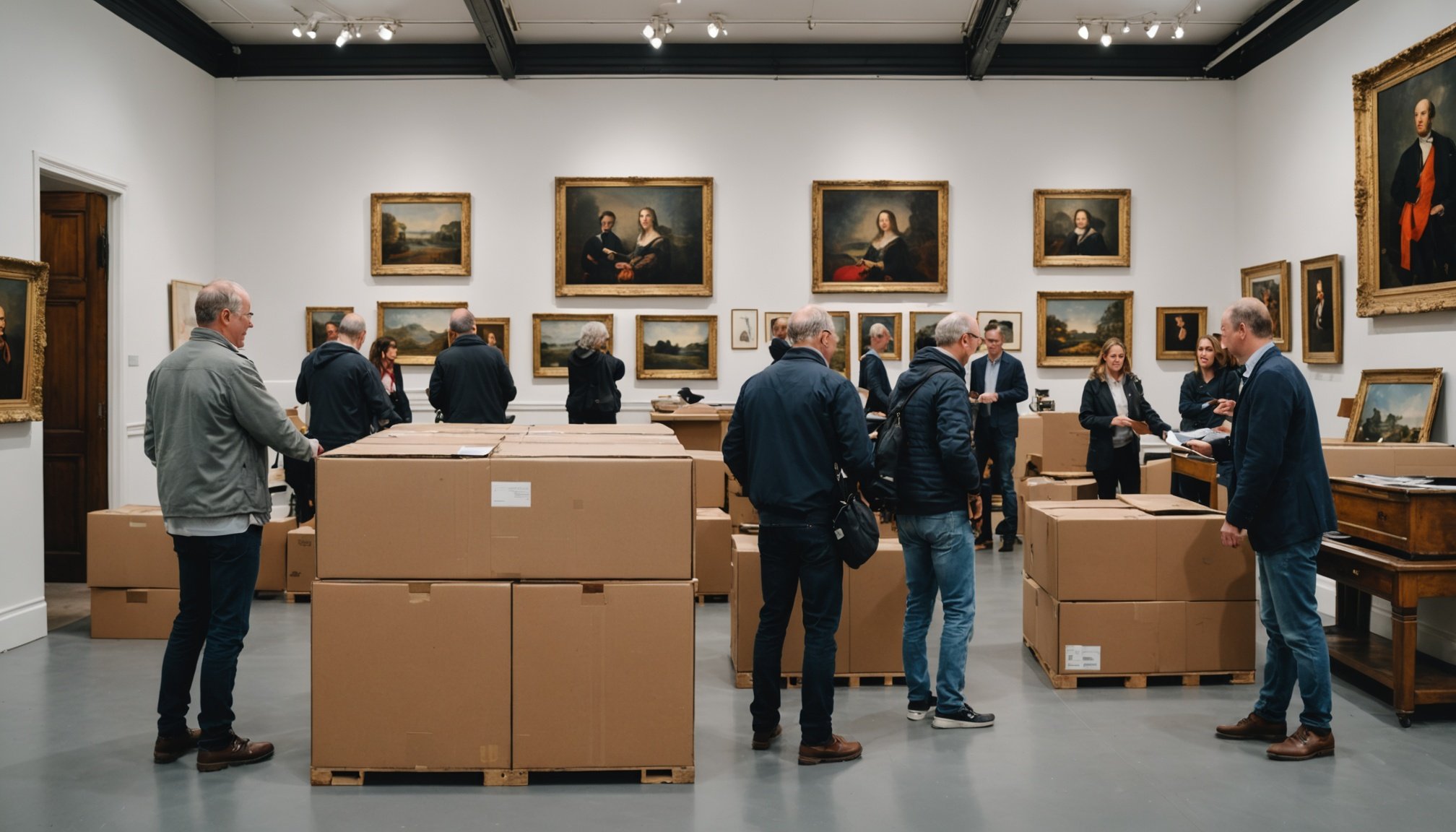Understanding the Importance of Proper Packing for High-Value Art
Transporting high-value art is fraught with risks if the importance of proper packing is not heeded. When art is inadequately packed, it is more susceptible to damage from shocks, vibrations, and temperature fluctuations during transit. Such mishaps can tarnish the integrity of artworks, leading to costly restorations.
The long-term effects of incorrect packing, however, extend beyond surface damage. Pieces may suffer structural degradation unseen at first glance, impacting their worth over time. Art collections gain lasting value through diligent preservation, underscoring why art packing safety is paramount.
Sujet a lire : Essential Steps to Safeguard Your Privacy When Relocating in the UK
When considering insurance during transport, ensuring proper packing is critical. Many insurance policies for high-value art specifically require evidence of professional packing. Failing to comply can result in denied claims. Therefore, prioritising secure packing is not just a physical measure but a financial safeguard as well.
To mitigate these risks, consider consulting experts in art packing safety. Utilizing industry-standard materials and techniques significantly reduces potential harm. Choices such as custom crates, padding, and climate-controlled transportation are vital elements to explore. This ensures that your treasures arrive at their destination in pristine condition, honouring both their artistry and investment value.
A lire également : Essential Guide to Properly Disposing of Unwanted Items Before Your Move in the UK
Essential Packing Materials for Art Moving
Moving artwork requires meticulous attention to detail, especially when it comes to selecting the right packing materials. These art moving supplies are designed to safeguard valuable pieces during transit.
Types of Packing Materials
To ensure the safe transport of your artwork, a variety of packing materials are necessary. Bubble wrap and foam padding are commonly used due to their ability to cushion items against shocks and vibrations. Custom crates and boxes, tailored to the dimensions of each piece, offer additional protection by keeping items secure and immobile. Packing tape and sealants are vital components, ensuring that each package remains closed tightly throughout the move.
Selecting Appropriate Cushioning
When handling fragile items, the use of soft materials is critical. These materials prevent scratches, dents, and other damage. An analysis of cushioning options showcases foam as a superior choice for delicate surfaces due to its malleability. Layering packing materials effectively involves wrapping the item adequately with initial soft materials before placing it into custom crates. This multi-layered approach enhances protection considerably.
Tools for Securing Art Pieces
To assemble and disassemble crates, reliable hand tools are indispensable. Measuring tools ensure precision when fitting artwork into custom crates, reducing movement. A heat gun can be applied to shrink wrap, providing a snug cover that further secures the artwork. Employing these tools ensures maximum safety during transportation.
Techniques for Packing Different Types of Art
When it comes to Packing Techniques for art, understanding the distinct needs of each piece is essential. The methods used often vary significantly between paintings and sculptures due to their different structures and materials.
Handling Fragile Art
Handling Fragile Art requires special attention to prevent damage during transport. For paintings, especially those with glass and frames, it’s crucial to use corner protectors and padded crates. This not only safeguards the edges but also mitigates the risk of shattering.
For sculptures, the Packing Techniques must accommodate their three-dimensional form. It’s common to use fitted foam or bespoke cases to envelop the sculpture’s contours snugly.
Material sensitivity plays a vital role. Some materials, particularly those in older artworks, can be drastically affected by changes in temperature and humidity. Using climate-controlled packaging can prevent warping, fading, or cracking.
Detailed Considerations
- Variation in Methods: Paintings often need flat, stable packaging, while sculptures may require customized, three-dimensional supports.
- Glass and Frame Protection: Use acid-free materials and corner guards.
- Environmental Conditions: Keeping art at stable temperatures helps maintain its integrity.
These techniques not only protect art during transit but also preserve its aesthetic and historical value.
Step-by-Step Guide to Packing High-Value Art
To ensure your precious pieces are transported without damage, follow a comprehensive art transportation guide. This process requires attention to detail and proper preparation.
Preparing the Artwork
Before commencing with the packing process, it is critical to prepare the artwork adequately. First, ensure all pieces are thoroughly cleaned using appropriate cleaning techniques. This involves using soft brushes or cloths to gently remove dust and dirt. For multi-part pieces, disassemble them securely to avoid damage during transit. Remember to document the existing conditions of each piece thoroughly. Taking high-resolution photographs and noting any pre-existing scratches or marks can be invaluable for insurance claims, should they arise.
Packing the Artwork Securely
After preparation, focus on packing the artwork securely. Start by layering protections like acid-free tissue paper and bubble wrap. Encasing the pieces in sturdy boxes or custom crates ensures added safety. Ensure stability within these containers using specialized cushioning materials. It is also wise to label each package with specific handling requirements, such as “fragile” or “this side up,” which guides proper handling by transport personnel.
Transport Considerations
Finally, consider transport logistics. Employ optimal loading techniques that maintain stability during transit. Ensure that climate control is maintained in transport vehicles to protect sensitive materials from temperature and humidity fluctuations. Providing clear handling instructions to movers will further safeguard your valuable artwork throughout the journey.
Legal and Insurance Aspects of Moving High-Value Art
Moving high-value art involves intricate considerations, particularly regarding art insurance and compliance with legal obligations. Ensuring complete art insurance coverage is vital for safeguarding investments. The process begins with professional appraisals, which accurately assess artwork values, tailoring the insurance coverage to match potential risks.
Understanding liability during transport is crucial. Liability agreements define who is responsible for any damage or loss incurred in transit. It’s imperative to work with reputable art shippers who offer comprehensive insurance policies, providing coverage from pickup to delivery.
Adhering to regulations governing the transport of high-value art is non-negotiable. Compliance involves respecting domestic and international laws, including export licenses, and customs documentation, particularly for cross-border moves. The penalties for non-compliance can be significant, ranging from fines to confiscation of artworks.
- Conduct thorough appraisals for precise insurance coverage
- Understand liability roles in transit
- Ensure compliance with transport regulations
These steps not only protect monetary investments but also preserve the integrity and provenance of fine art collections. Professionals specializing in art logistics often offer guidance, ensuring that both legal considerations and insurance requirements are met seamlessly. By understanding these aspects, art owners can confidently navigate the complexities of relocating treasures.
Case Studies and Success Stories
Understanding the intricacies of art moving case studies unveils the triumphs and obstacles within this specialised domain. Artworks, due to their fragile and invaluable nature, pose unique challenges during transport. Successful stories in this field often highlight how meticulous planning and innovative strategies are implemented to overcome these challenges.
Overview of Successful Art Moves
Art handlers often face unique challenges, such as climate control and the handling of oversized pieces. To mitigate risks, they implement strategies like custom crate design and attentive route planning. For instance, using state-of-the-art shock absorption packaging can significantly enhance the safety of fragile items. Furthermore, employing real-time tracking systems ensures the continuous safety monitoring of artworks in transit.
Lessons Learned from Failed Moves
Unfortunately, not all art moves achieve success. Analyzing past mishaps in art transport can provide valuable insights. Common errors include inadequate packing techniques and poor route choices. From these, key takeaways emerge: the importance of success in packing cannot be understated. Recommendations based on previous experiences stress the necessity of comprehensive risk assessments.
By learning from both successful and failed instances, future relocations can leverage these insights. This approach not only optimises efficiency but also fortifies the protection of priceless artistic creations. Employing advanced technologies and adhering to best practices can significantly reduce the probability of errors in art transportation.
Visual Aids and Resources for Effective Art Packing
Packing art can be a delicate task, demanding both precision and attention to detail. Visual aids play a crucial role in ensuring that artwork is packed securely and properly. They assist in transforming complex instructions into understandable steps through illustrations and videos. For those venturing into art packing, utilising these aids can dramatically enhance understanding and accuracy.
Various art packing guides are available, specifically tailored to different types of artwork. These guides often provide comprehensive step-by-step instructions supported by images, making it easier to follow along. Additionally, there are several online tutorials that walk you through the art packing process. These can be particularly beneficial for visual learners who absorb information best through demonstration.
Furthermore, many platforms offer downloadable resources and checklists designed to simplify the packing process. These checklists ensure you don’t forget crucial steps or materials needed for safely packing your art pieces. Often, these resources are devised by experts in the field, lending them credibility and value.
For those serious about protecting their art investments, combining a thorough guide with practical visual resources ensures both safety and peace of mind. These tools empower individuals to pack artwork with confidence, mitigating potential damage during transport.











